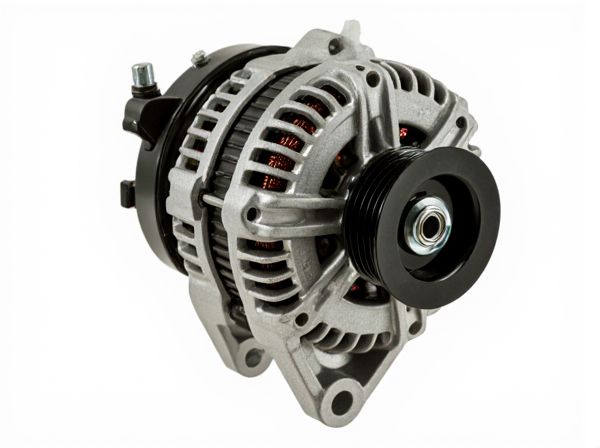
Photo illustration: Brush-Type vs Brushless
Brushless motors offer higher efficiency, longer lifespan, and reduced maintenance compared to brush-type motors, which rely on physical brushes to transfer electrical current. You will find brushless motors generate less noise and heat, making them ideal for applications requiring reliability and quiet operation. Brush-type motors, while more affordable and easier to repair, tend to experience faster wear and lower performance in demanding environments.
Table of Comparison
| Feature | Brush-Type Alternator | Brushless Alternator |
|---|---|---|
| Construction | Uses brushes and slip rings | Uses diode rectifier, no brushes |
| Maintenance | Requires periodic brush replacement | Low maintenance, no brush wear |
| Durability | Moderate, affected by brush wear | High, longer service life |
| Efficiency | Lower due to brush friction | Higher, reduced electrical losses |
| Cost | Generally lower upfront cost | Higher initial investment |
| Noise | Brush noise present | Quieter operation |
| Common Usage | Older or budget vehicles | Modern vehicles, performance cars |
Introduction to Brush-Type and Brushless Motors
Brush-type motors use carbon brushes to conduct electrical current between stationary and rotating parts, creating friction and wear over time, which typically results in higher maintenance requirements. Brushless motors eliminate brushes by utilizing electronic commutation with permanent magnets on the rotor, offering greater efficiency, longer lifespan, and reduced noise. The fundamental difference lies in their construction and operation, impacting performance, durability, and application suitability.
Key Differences Between Brush-Type and Brushless Motors
Brush-type motors use mechanical brushes and a commutator to deliver current to the motor windings, causing friction and wear that reduce efficiency and lifespan. Brushless motors rely on electronic controllers to switch current through the windings, leading to higher efficiency, less maintenance, and longer durability. Key differences include brushless motors offering quieter operation, better performance at high speeds, and greater energy efficiency compared to brush-type motors.
Understanding How Brush-Type Motors Work
Brush-type motors operate by using carbon brushes to transfer electrical current through a commutator, enabling the rotor to spin and produce mechanical motion. This design causes friction and wear on the brushes, leading to reduced efficiency and maintenance requirements over time. Understanding the interaction between brushes and the commutator is crucial for optimizing performance in applications where torque and speed control are essential.
How Brushless Motors Function
Brushless motors function through electronic commutation, where sensors detect the rotor's position and a controller switches current to the stator coils, generating a rotating magnetic field that drives the rotor without physical brushes. This design reduces friction and wear, resulting in higher efficiency, lower maintenance, and longer lifespan compared to traditional brushed motors. Brushless motors are widely used in applications requiring precise speed control and reliability, such as drones, electric vehicles, and industrial robotics.
Performance Comparison: Speed, Torque, and Efficiency
Brushless motors deliver higher speeds and greater torque compared to brush-type motors due to their electronic commutation and reduced friction. Brushless designs achieve superior efficiency by minimizing energy loss from brush friction and electrical resistance, resulting in longer operational life and less heat generation. In contrast, brush-type motors typically experience lower speed capabilities and torque output, coupled with decreased efficiency and more frequent maintenance requirements.
Maintenance Requirements: Brush-Type vs Brushless
Brush-type motors require regular maintenance such as brush replacement and commutator cleaning due to wear from friction, which can lead to decreased efficiency and motor lifespan. Brushless motors have significantly lower maintenance needs since they lack brushes, reducing mechanical wear and improving reliability. This difference makes brushless motors preferable for applications demanding long-term durability and minimal upkeep.
Lifespan and Durability Considerations
Brushless motors offer superior lifespan and durability compared to brush-type motors due to the absence of brushes that wear out over time, reducing maintenance needs and increasing operational efficiency. Brush-type motors experience gradual degradation of brushes and commutators, leading to shorter service intervals and potential performance drops. Investing in brushless technology results in longer-lasting equipment with enhanced reliability, particularly in high-demand industrial and commercial applications.
Cost Analysis and Affordability
Brush-type motors typically have lower upfront costs due to simpler construction and widespread availability, making them more affordable for budget-conscious buyers. Brushless motors, while initially more expensive, offer longer lifespan and reduced maintenance expenses, resulting in lower total cost of ownership over time. Evaluating the balance between purchase price and durability is essential for cost-effective motor selection in various applications.
Common Applications for Each Motor Type
Brush-type motors are commonly used in household appliances, power tools, and automotive applications due to their simple design and cost-effectiveness. Brushless motors find frequent use in drones, electric vehicles, and computer cooling systems, offering higher efficiency, longer lifespan, and quieter operation. Industrial automation and robotics often prefer brushless motors for precise control and reduced maintenance requirements.
Choosing the Right Motor: Factors to Consider
Brushless motors offer higher efficiency, longer lifespan, and reduced maintenance compared to brush-type motors, making them ideal for applications requiring durability and consistent performance. Brush-type motors tend to be more cost-effective and simpler to repair, suitable for budget-conscious projects with less demanding operational needs. When choosing the right motor, consider factors such as operational environment, required torque and speed, maintenance capabilities, and initial investment costs to align motor selection with specific application requirements.
 caratoz.com
caratoz.com